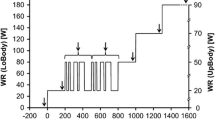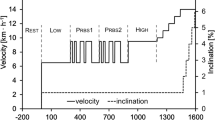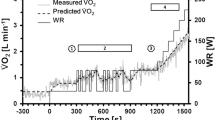Abstract
Purpose
The aim of the study was to test for significant differences in non-invasively estimated muscle oxygen uptake (\(\dot {V}{{\text{O}}_{2{\text{musc}}}}\)) kinetics, assessed by a square-wave exercise protocol (STEP) as well as by a time series approach with pseudorandom binary sequence (PRBS) work rate (WR) changes.
Methods
Seventeen healthy and active individuals (10 women, 7 men; 23 ± 2 years old; height 175 ± 11 cm; body mass 73 ± 14 kg [mean ± SD]) completed five repetitions of WR transitions from 30 to 80 W for the STEP approach and two sequences of pseudorandom binary WR changes between 30 and 80 W for the PRBS approach. Pulmonary oxygen uptake (\(\dot {V}{{\text{O}}_{2{\text{pulm}}}}\)) was measured breath by breath. \(\dot {V}{{\text{O}}_{2{\text{musc}}}}\) kinetics were estimated during phase II \(\dot {V}{{\text{O}}_{2{\text{pulm}}}}\) in the STEP approach and during the pseudorandom binary sequence WR changes in the PRBS approach.
Results
No significant differences were observed between different models of the STEP and the PRBS approach for estimation of \(\dot {V}{{\text{O}}_{2{\text{musc}}}}\) kinetics (p > 0.05). In addition, a very high variability between the models was determined for \(\dot {V}{{\text{O}}_{2{\text{musc}}}}\) kinetics [mean time constants (τ) difference: − 2.5 ± 11.4 s]. A significant correlation for τ of \(\dot {V}{{\text{O}}_{2{\text{musc}}}}\) between the STEP approach with experimentally determined phase I \(\dot {V}{{\text{O}}_{2{\text{pulm}}}}\) lengths and the PRBS approach was noticed (r = 0.536; p < 0.05).
Conclusions
Both approaches (STEP and PRBS) are not significantly different for estimating the \(\dot {V}{{\text{O}}_{2{\text{musc}}}}\) kinetics, but the very high variability impairs the predictability between the models. However, the determination of the length of phase I \(\dot {V}{{\text{O}}_{2{\text{pulm}}}}\) should be as appropriate as possible because predefined duration lengths can result in overestimations in \(\dot {V}{{\text{O}}_{2{\text{musc}}}}\) kinetics.





Similar content being viewed by others
Abbreviations
- CCF:
-
Cross-correlation function
- CCFlag (s):
-
Lag of CCFmax
- CCFmax (a.u.):
-
Maximum (peak) of cross-correlation function
- HR (min−1):
-
Heart rate
- PRBS:
-
Approach implying pseudorandom binary sequence work rate changes combined with time series analysis
- \(\dot {Q}\) (L min−1):
-
Cardiac output
- \({\dot {Q}_{{\text{musc}}}}\) (L min−1):
-
Exercising leg muscle blood flow
- \({\dot {Q}_{{\text{rem}}}}\) (mL min−1):
-
Perfusion of non-exercising tissues
- STEP:
-
Approach implying repeated step responses in work rate combined with exponential data-fitting procedures
- SVex (mL):
-
Exercise stroke volume
- τ (s):
-
Time constant of mono-exponential function
- TD (s):
-
Time delay of mono-exponential function
- \(\dot {V}{{\text{O}}_{2{\text{max}}}}\) (L min−1):
-
Maximal oxygen uptake
- \(\dot {V}{{\text{O}}_{2{\text{musc}}}}\) (L min−1):
-
Exercising muscle oxygen uptake
- \(\dot {V}{{\text{O}}_{2{\text{pulm}}}}\) (L min−1):
-
Pulmonary oxygen uptake
- \(\dot {V}{{\text{O}}_{2{\text{rem}}}}\) (L min−1):
-
Oxygen uptake in non-exercising tissues
- V v (mL):
-
Venous blood volume
- WR (W):
-
Work rate
References
Barstow TJ, Molé PA (1987) Simulation of pulmonary O2 uptake during exercise transients in humans. J Appl Physiol 63:2253–2261
Barstow TJ, Molé PA (1991) Linear and nonlinear characteristics of oxygen uptake kinetics during heavy exercise. J Appl Physiol 71:2099–2106
Barstow TJ, Scheuermann BW (2005) VO2 kinetics: effects of maturation and ageing. In: Jones AM, Poole DC (eds) Oxygen uptake kinetics in sport, exercise and medicine. Routledge, New York, pp 331–352
Barstow TJ, Lamarra N, Whipp BJ (1990) Modulation of muscle and pulmonary O2 uptakes by circulatory dynamics during exercise. J Appl Physiol 68:979–989
Barstow TJ, Buchthal S, Zanconato S, Cooper DM (1994) Muscle energetics and pulmonary oxygen uptake kinetics during moderate exercise. J Appl Physiol 77:1742–1749
Bearden SE, Moffatt RJ (2001) \(\dot {V}{{\text{O}}_2}\) and heart rate kinetics in cycling: transitions from an elevated baseline. J Appl Physiol 90:2081–2087
Benson AP, Grassi B, Rossiter HB (2013) A validated model of oxygen uptake and circulatory dynamic interactions at exercise onset in humans. J Appl Physiol 115:743–755
Benson AP, Bowen TS, Ferguson C, Murgatroyd SR, Rossiter HB (2017) Data collection, handling, and fitting strategies to optimize accuracy and precision of oxygen uptake kinetics estimation from breath-by-breath measurements. J Appl Physiol 123:227–242
Buchheit M, Laursen PB, Ahmaidi S (2009) Effect of prior exercise on pulmonary O2 uptake and estimated muscle capillary blood flow kinetics during moderate-intensity field running in men. J Appl Physiol 107:460–470
Cochrane JE, Hughson RL (1992) Computer simulation of O2 transport and utilization mechanisms at the onset of exercise. J Appl Physiol 73:2382–2388
Dupont G, Millet GP, Guinhouya C, Berthoin S (2005) Relationship between oxygen uptake kinetics and performance in repeated running sprints. Eur J Appl Physiol 95:27–34
Eßfeld D, Hoffmann U, Stegemann J (1991) A model for studying the distortion of muscle oxygen uptake patterns by circulation parameters. Eur J Appl Physiol 62:83–90
Grassi B, Poole DC, Richardson RS, Knight DR, Erickson BK, Wagner PD (1996) Muscle O2 uptake kinetics in humans: implications for metabolic control. J Appl Physiol 80:988–998
Grassi B, Pogliaghi S, Rampichini S, Quaresima V, Ferrari M, Marconi C, Cerretelli P (2003) Muscle oxygenation and pulmonary gas exchange kinetics during cycling on-transitions in humans. J Appl Physiol 95:149–158
Grassi B, Rossiter HB, Zoladz JA (2015) Skeletal muscle fatigue and decreased efficiency: two sides of the same coin? Exerc Sport Sci Rev 43:75–83
Hoffmann U, Drescher U, Benson AP, Rossiter HB, Eßfeld D (2013) Skeletal muscle VO2 kinetics from cardio-pulmonary measurements: assessing distortions through O2 transport by means of stochastic work-rate signals and circulatory modelling. Eur J Appl Physiol 113:1745–1754
Hughson RL (2009) Oxygen uptake kinetics: historical perspective and future directions. Appl Physiol Nutr Metab 34:840–850
Koga S, Poole DC, Shiojiri T, Kondo N, Fukuba Y, Miura A, Barstow TJ (2005) Comparison of oxygen uptake kinetics during knee extension and cycle exercise. Am J Physiol Regul Integr Comp Physiol 288:R212-R220
Koga S, Rossiter HB, Heinonen I, Musch TI, Poole DC (2014) Dynamic heterogeneity of exercising muscle blood flow and O2 utilization. Med Sci Sports Exerc 46:860–876
Krustrup P, Jones AM, Wilkerson DP, Calbet JA, Bangsbo J (2009) Muscular and pulmonary O2 uptake kinetics during moderate- and high-intensity sub-maximal knee-extensor exercise in humans. J Physiol 587:1843–1856
Lai N, Camesasca M, Saidel G, Dash RK, Cabrera ME (2007) Linking pulmonary oxygen uptake, muscle oxygen utilization and cellular metabolism during exercise. Ann Biomed Eng 35:956–969
Lamarra N, Whipp BJ, Ward SA, Wasserman K (1987) Effect of interbreath fluctuations on characterizing exercise gas exchange kinetics. J Appl Physiol 62:2003–2012
Ma S, Rossiter HB, Barstow TJ, Casaburi R, Porszasz J (2010) Clarifying the equation for modeling of \(\dot {V}{{\text{O}}_2}\) kinetics above the lactate threshold. J Appl Physiol 109:1283–1284
Mezzani A, Grassi B, Giordano A, Corrà U, Colombo S, Giannuzzi P (2010) Age-related prolongation of phase I of \(\dot {V}{{\text{O}}_2}\) on-kinetics in healthy humans. Am J Physiol Regul Integr Comp Physiol 299:R968–R976
Mortensen SP, Dawson EA, Yoshiga CC, Dalsgaard MK, Damsgaard R, Secher NH, González-Alonso J (2005) Limitations to systemic and locomotor limb muscle oxygen delivery and uptake during maximal exercise in humans. J Physiol 566:273–285
Murgatroyd SR, Ferguson C, Ward SA, Whipp BJ, Rossiter HB (2011) Pulmonary O2 uptake kinetics as a determinant of high-intensity exercise tolerance in humans. J Appl Physiol 110:1598–1606
Murias JM, Kowalchuk JM, Paterson DH (2010) Speeding of \(\dot {V}{{\text{O}}_2}\) kinetics with endurance training in old and young men is associated with improved matching of local O2 delivery to muscle O2 utilization. J Appl Physiol 108:913–922
Murias JM, Spencer MD, Kowalchuk JM, Paterson DH (2011) Influence of phase I duration on phase II VO2 kinetics parameter estimates in older and young adults. Am J Physiol Regul Integr Comp Physiol 301:R218-R224
Poole DC, Jones AM (2012) Oxygen uptake kinetics. Compr Physiol 2:933–996
Press WH (2007) Numerical recipes 3rd edition: the art of scientific computing. Cambridge University Press, Cambridge
Regensteiner JG, Bauer TA, Reusch JE, Brandenburg SL, Sippel JM, Vogelsong AM, Hiatt WR (1998) Abnormal oxygen uptake kinetic responses in women with type II diabetes mellitus. J Appl Physiol 85:310–317
Roditis P, Dimopoulos S, Sakellariou D, Sarafoglou S, Kaldara E, Venetsanakos J, Nanas S (2007) The effects of exercise training on the kinetics of oxygen uptake in patients with chronic heart failure. Eur J Cardiovasc Prev Rehabil 14:304–311
Rossiter HB, Ward SA, Kowalchuk JM, Howe FA, Griffiths JR, Whipp BJ (2002) Dynamic asymmetry of phosphocreatine concentration and O2 uptake between the on- and off- transients of moderate- and high-intensity exercise in humans. J Physiol 541:991–1002
Whipp BJ, Ward SA, Lamarra N, Davies JA, Wasserman K (1982) Parameters of ventilatory and gas exchange dynamics during exercise. J Appl Physiol 52:1506–1513
Whipp BJ, Higgenbotham MB, Cobb FC (1996) Estimating exercise stroke volume from asymptotic oxygen pulse in humans. J Appl Physiol 81:2674–2679
Yoshida T, Abe D, Fukuoka Y, Hughson RL (2008) System analysis for oxygen uptake kinetics with step and pseudorandom binary sequence exercise in endurance athletes. Meas Phys Educ Exerc Sci 12:1–9
Acknowledgements
This study was supported by the German Space Agency (DLR—Deutsches Zentrum für Luft- und Raumfahrt, FKZ 50WB1626).
Author information
Authors and Affiliations
Corresponding author
Ethics declarations
Conflict of interest
The authors declare that they have no conflict of interest.
Additional information
Communicated by I. Mark Olfert.
Rights and permissions
About this article
Cite this article
Drescher, U., Schmale, R., Koschate, J. et al. Non-invasive estimation of muscle oxygen uptake kinetics with pseudorandom binary sequence and step exercise responses. Eur J Appl Physiol 118, 429–438 (2018). https://doi.org/10.1007/s00421-017-3785-8
Received:
Accepted:
Published:
Issue Date:
DOI: https://doi.org/10.1007/s00421-017-3785-8




